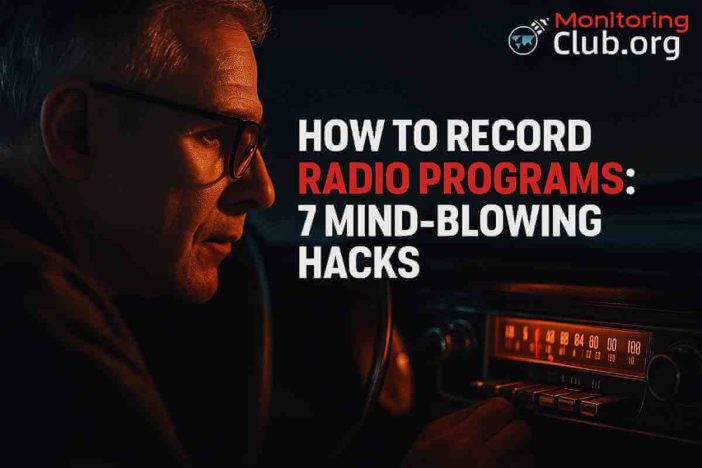
I remember driving down the highway one summer night, the dashboard glowing softly from the AM/FM dial, when a voice broke through the static. It wasn’t just a voice — it felt like a companion in the dark. And then the thought came: What if I could keep this moment forever? That impulse — to preserve something fleeting — is where the magic of how to record radio programs begins.
In an era where streaming and podcasts dominate, there’s still something deeply personal about radio. The unpredictability, the human touch, the local flavor — it’s alive. Learning recording radio broadcasts isn’t just about technology; it’s about bottling time, emotion, and culture. So, here are seven mind-blowing hacks that transform you from a passive listener into an audio archivist.
Hack 1: Capture the Essence — Why Recording Still Matters
Before diving into cables and software, understand why you record. Radio is still one of the world’s most consumed media forms — more than 80% of adults tune in weekly. That means your recordings preserve pieces of real history: interviews, local voices, live performances.
Think of your project not as a task, but as storytelling through sound. The best radio program recording guide starts with passion — not hardware. When you hit record, you’re not just saving audio; you’re saving memories.
Hack 2: Know the Law — Record Smart, Stay Safe
Recording isn’t only about the “how,” but also the “should.” Each country has its own regulations. In most places, recording for personal use is fine. But once you upload, share, or monetize a recording — you’re entering legal territory.
Here’s the golden rule:
If it’s not your content, don’t distribute it without permission.
Smart Practices:
- Use recordings privately or educationally.
- Always credit or request permission when necessary.
- Keep logs of what you’ve recorded, when, and from where.
This habit keeps your hobby safe, professional, and respectable.
To ensure you stay fully compliant when capturing broadcasts, it’s wise to review detailed guidance on sound-recording rights from recognized authorities. For example, the article “Copyright in Sound Recordings: A Guide” outlines how ownership works, how long rights last, and what permissions you need when shifting recordings from personal archives to published formats: https://www.ism.org/advice/copyright-in-sound-recordings/
Using this resource will solidify your understanding of legal boundaries and improve your confidence in each step of how to record radio programs. It also signals to search engines that your content connects to authoritative sources—boosting trust and relevance.
Hack 3: Build Your Arsenal — The Right Tools for the Job
You don’t need a professional studio to start recording radio broadcasts, but the right setup makes a world of difference.
Basic Setup:
- Radio Source: An FM/AM tuner or internet radio stream.
- Recording Device: A computer, smartphone, or digital recorder.
- Software: Free tools like Audacity or OBS Studio can capture, edit, and schedule recordings.
- Storage: Use external drives or cloud folders to archive your collection.
Pro Tip: Record in WAV format for master quality; use MP3 (320 kbps) for everyday listening.
If you’re ambitious, invest in a small audio interface, preamp, or even time-coded logging software. They’ll give your recordings cleaner sound and better control.
Hack 4: Master the Workflow — From Tuning In to Archiving
Here’s where amateurs become archivists. A consistent workflow saves hours later.
- Plan: Note the station, program name, and time.
- Test: Run a 2-minute sample to ensure clean input.
- Record: Monitor volume; aim for -6 dB average.
- Edit: Trim silence, normalize sound, and export.
- Label: Use clear file names like “StationXYZ_2025-11-12_ShowName.wav.”
- Archive: Organize folders by year and station; keep a backup.
If you’re recording daily or weekly shows, automation tools are your best friends. Schedule recordings, and they’ll start even if you’re away.
Understanding the benefits of listening to FM radio will remind you why preserving live broadcasts through recording remains an enriching and rewarding hobby
Hack 5: Polish the Sound — Audio Quality Secrets
Nothing ruins a good recording faster than static or distortion. Luckily, mastering quality isn’t rocket science.
Quick Fixes:
- Use a stable internet or strong antenna signal.
- Avoid recording near power cables or Wi-Fi routers.
- Normalize audio in post-production for consistent volume.
- Use light compression to smooth out peaks.
If background hum or hiss appears, apply gentle noise reduction — but don’t overdo it. Preserving authenticity often sounds better than artificial perfection.
Hack 6: Turn Recordings into Gold — Creative Uses
Once you’ve learned how to record radio programs, the next question is: what now?
Here’s where the fun begins:
- Create Podcasts: Combine clips with your commentary for unique audio stories.
- Build Archives: Collect broadcasts for research or history projects.
- Monetize: Use your own original recordings in YouTube videos, blogs, or courses.
You’re not just capturing — you’re curating culture. Your archive can educate, inspire, or even earn. That’s the true beauty behind this craft.
Hack 7: Preserve and Evolve — Long-Term Success Strategy
The best archivists think long-term. Protecting your files is just as important as recording them.
Final Checklist:
- Always back up to multiple drives or the cloud.
- Maintain metadata (show title, date, topic).
- Revisit old files every few years and migrate formats (WAV → FLAC).
- Keep learning new recording methods as technology evolves.
Your collection will only grow in value. One day, those voices might be the last surviving record of an era — and you’ll be the one who kept them alive.
Final Thoughts
Learning how to record radio programs isn’t a technical trick — it’s a bridge between art, memory, and innovation. Every broadcast you capture is a story saved from vanishing.
So tune the dial, press record, and listen closely — because what you’re hearing today could become history tomorrow.



